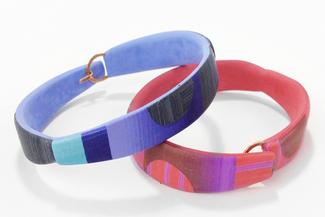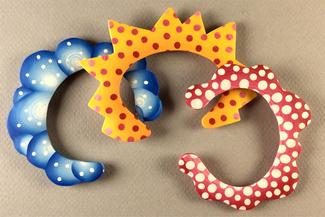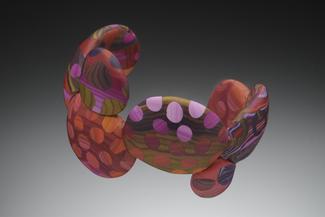Polymer Bracelets with Wire Armatures
In this class, students will explore the use of polymer clay and wire to create their own bracelets from start to finish. Instead of relying on pre-fabricated findings or soldering to dictate their forms, they will learn how to form and harden wire to create a "skeleton" for polymer veneers. Additionally, student will be introduced to Apoxie clay to create sculpted forms. Bonnie will also demonstrate how to create polymer veneers with simple marquetry techniques.
Demonstrations will focus on creating a flexible hook and loop bracelet, a tall cuff, and a sculptural cuff. If students have worked with polymer clay before, they can use previously constructed cane designs or create new ones in class.
Meet the instructor

Bonnie Bishoff has worked collaboratively with her artistic partner and husband J. M. Syron since 1987. Starting as furniture makers, they made work that incorporated large panels of polymer veneers for 28 years. Gradually they shifted their focus to explore jewelry and mixed media pieces.They tend to work in series and on several fronts at once. The focus of their jewelry has been creating metal armatures, textured and oxidized metal surfaces, and polymer marquetry surface designs. In addition they have been exploring a series of wall panels or "paintings" in polymer veneers and wire armatured sculptures.
They have exhibited widely in galleries and fine craft shows including the Smithsonian and the Philadelphia Museum of Art. Museum exhibitions include the Peabody Essex, The Museum of Art and Design, NY and the permanent collection of the Racine Art Museum. Their materials include veneers of polymer clay, silver, bronze, copper, and wood. They aim to create work that projects an expansive notion of art and creative pursuit to be shared by the wearer with the world.
Materials & Tools
There is a $45 materials fee for this workshop that is payable upon registration. This materials fee covers the use of studio equipment, polymer clay, 10 gauge and 18 gauge wire, translucent liquid sculpey, black Apoxie Sculpt, polyblade, X-acto, and various other miscellaneous materials necessary for the workshop.
From online, AC Moore, Joann Fabrics, Blick, Munroecraft.com
- pasta machine with crank handle and clamp for table
- small cutting surface/mat such as a plastic cutting board
- acrylic brayer or acrylic roller
- burnishing tool such as a bone folding tool, wooden “thumb”clay sculpting tool, spoon or doorknob
- small inexpensive paint brush for liquid sculpey application
- waxed paper
- optional: small shape cutters for clay or culinary use



